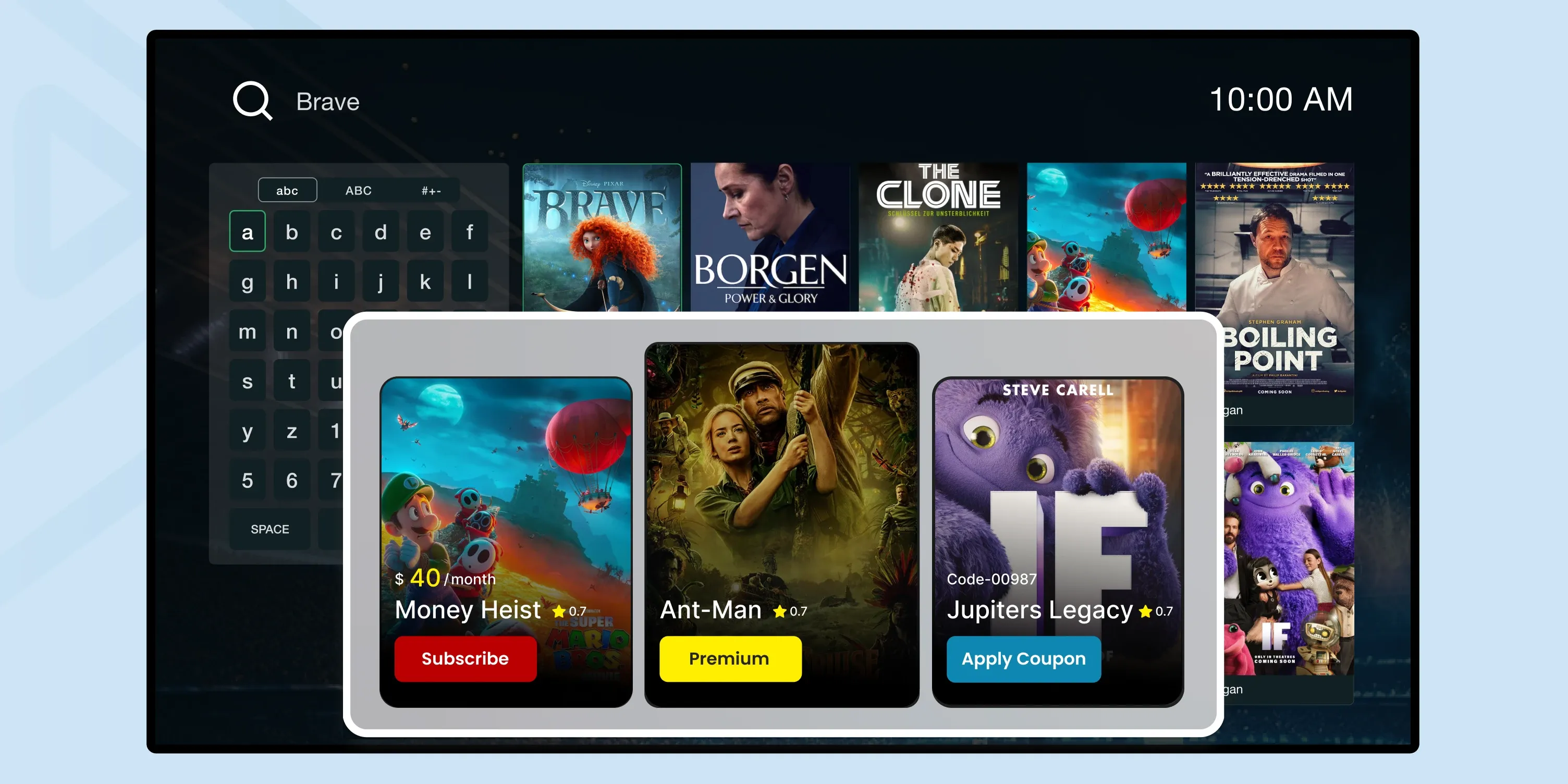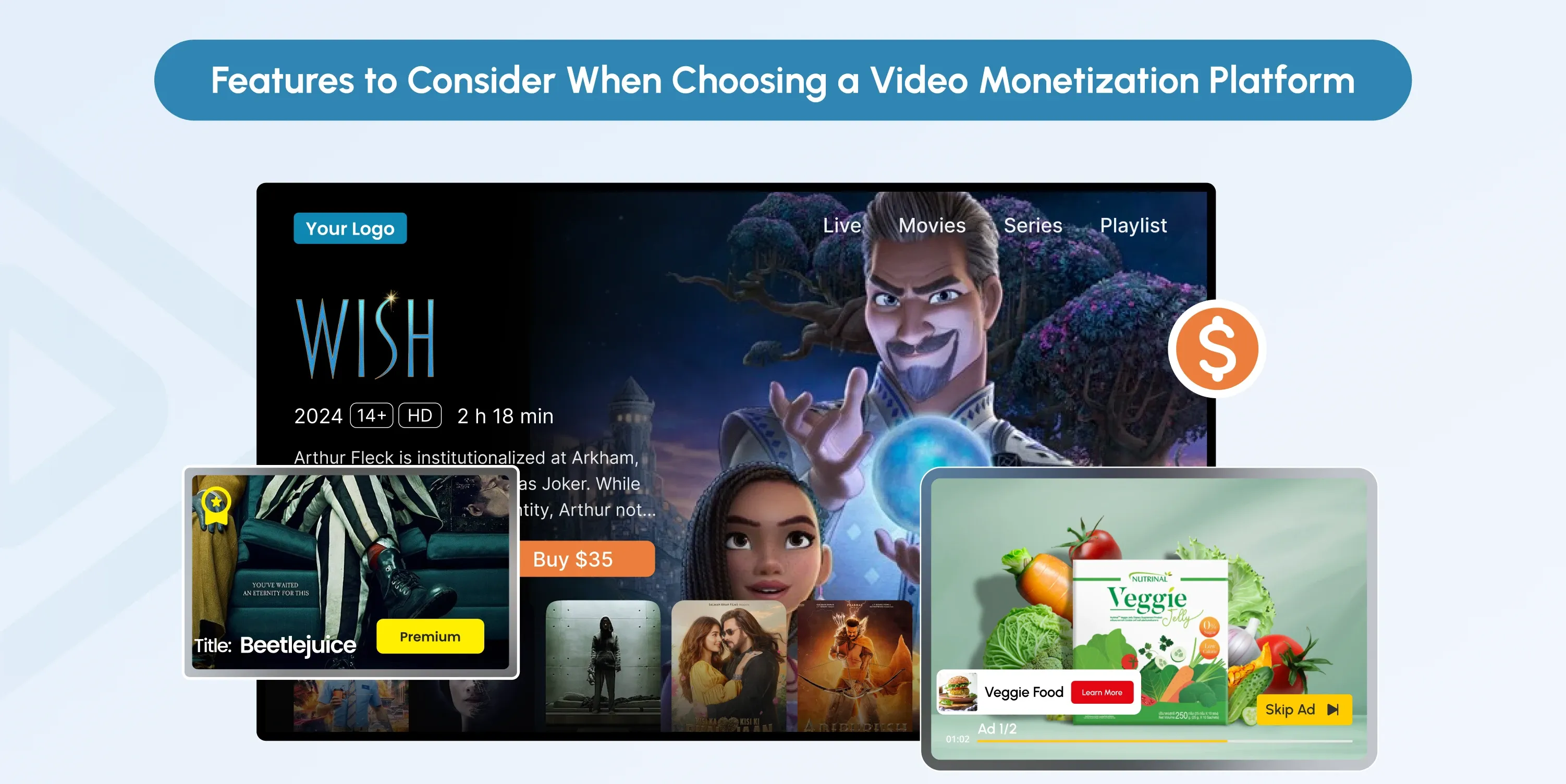
Top 4 Video Monetization Platforms in 2025
Just like Hollywood blockbusters and bestselling novels, great video content deserves a revenue model that keeps the profits rolling in.
Imagine if Game of Thrones had no HBO subscription model or if Avengers: Endgame skipped theater ticket sales - monetization matters!
Finding the right platform is important to turn your videos into a revenue-generating powerhouse if you’re a content creator, IPTV provider, or media company.
This guide will tell you about the top four monetization platforms and introduce you to the best strategies, tips, and tools for video monetization.

Key Takeaways
- The top four monetization platforms of 2025 are YouTube, Facebook, Instagram, and Vimeo
- YouTube remains one of the best video monetization platforms for creators. It offers several ways to earn, including ads, channel memberships, and live stream Super Chats.
- Facebook is a great place to profit since it has a large user base thanks to the various video modes it uses, including live streaming and video advertisements.
- Instagram is a top video monetization platform for visual storytelling through videos. Creators can connect with their audience using Stories, Reels, and IGTV
What is Video Monetization?
Video monetization is the process of earning money from your video content in a professional manner. Typically, this involves using multiple revenue streams, making your audience pay to access your content.
Making money from online video content largely relies on leveraging platforms that allow creators to integrate advertisements and other revenue-generating tools. What’s important to note is that different video monetization platforms offer unique ways for creators to maximize their earnings. This control allows them to tailor their monetization strategy to their audience’s preferences, helping them grow revenue effectively.
Types of Video Monetization Platforms
When it comes to video monetization, choosing the right platform can significantly impact your earnings. Understanding monetization types can help you select the platform that best suits your content and audience.
Subscription-Based Platforms
Known as SVOD, the subscription-based video-on-demand model is an ideal video monetization strategy for content creators who regularly produce fresh content, as well as for viewers who enjoy accessing a wide variety of videos at their convenience.
With SVOD, subscribers pay a monthly fee to unlock unlimited access to video libraries or live streams.
This subscription model benefits both creators and viewers. It offers a steady income stream for creators while subscribers get continuous access to new content.
Platforms Based on Advertisements and Sponsorships
Advertising-based video-on-demand (AVOD) allows companies and creators to profit by including commercials in their videos or collaborating with sponsors and marketers.
This type of video monetization is common on platforms like YouTube and other video ad monetization platforms. While this strategy can generate substantial revenue, it also has potential downsides, such as fluctuating earnings and the possibility of annoying viewers with excessive ads.
TVOD Platforms
Transactional video-on-demand (TVOD), lets users pay a single charge to view particular videos or live streams. For events including conferences, concerts, and upscale seminars, this model performs brilliantly.
The TVOD platform is something creators should consider. It allows them to profit from their content without involving memberships, thereby saving money.
Hybrid Platforms
Hybrid video monetization platforms combine multiple revenue models, giving you the flexibility to maximize your income. By integrating approaches like pay-per-view (PPV), subscriptions, ads, and donations, these platforms provide creators with more freedom to diversify their earnings.
Adapting to changing audience preferences and market trends becomes easier when you have multiple revenue streams. inoRain can help you with that. Contact us today to start monetizing your content.
What to Look For When Choosing the Right Video Monetization Platform?
Choosing the correct video monetization solution will significantly influence both the income you earn and the number of views your videos get.
 Here are six factors to consider when choosing a video monetization platform:
Here are six factors to consider when choosing a video monetization platform:
1. Audience Demographics and Reach
To successfully monetize video content, you need to define your target audience and determine where they spend most of their time online. Different video monetization platforms attract different demographics.
For example, younger audiences tend to prefer TikTok and Instagram, while YouTube has a global user base across various age groups. Choosing a platform that aligns with your audience's age, interests, and viewing habits will help maximize engagement and boost your income potential.
2. Monetization Options
Explore the various income sources available on different video monetization platforms. Some platforms, like YouTube, offer multiple ways to earn, including ads, memberships, and Super Chats. Others may offer pay-per-view (PPV) options, subscription plans, or viewer-direct donations. Select a platform that aligns with your video monetization goals and supports multiple revenue streams to fit your content strategy.
3. Platform Fees and Revenue Sharing
Different platforms charge different fees and have varying revenue-sharing models. Platforms like YouTube and Facebook typically share ad revenue, while others may take a higher percentage or charge upfront fees. Be sure to understand how much of your earnings will go to the platform. Choose one that offers fair and sustainable revenue sharing to maximize your income over time.
4. Content Control and Customization
Consider the level of control you want over your content. For example, content monetization platforms like Vimeo provide more options for customizing video players, branding, and user experience- allowing you to maintain a consistent brand identity. Platforms that let you control ad placement and frequency can also help you balance monetization with a positive user experience.
5. Content Protection and Security
If you’re producing your high-quality or unique content, it’s rather crucial to ensure its safety. Search for platforms with robust Digital Rights Management (DRM) and anti-piracy policies to prevent your movies from being viewed and shared without your permission. Considering this is extremely crucial, particularly if you wish to profit from your efforts.
6. Analytics and Performance Tracking
Comprehensive analytics are crucial for optimizing your content and understanding your audience. Metrics like view counts, watch times, engagement rates, and audience demographics help you improve your content strategy and maximize your revenue. Choose a video monetization platform with advanced tracking features that will support your goals and boost your earnings.
Top 4 Video Monetization Platforms
 Let’s take a look at the top four platforms to monetize videos, their advantages, and potential drawbacks:
Let’s take a look at the top four platforms to monetize videos, their advantages, and potential drawbacks:
YouTube
With a massive global user base, YouTube remains one of the best video monetization platforms for creators. It offers several ways to earn, including ads, channel memberships, and livestream Super Chats. YouTube's strong presence in Google Search results can also boost your visibility. However, the platform is highly competitive, making it tough for new creators to stand out and gain attention quickly.
If you want to monetize live streams, Facebook is a great place to profit since it boasts a large user base and sophisticated targeting features. Various video modes, including live streaming and video advertisements, allow producers to interact with their audience in many different ways.
Still, your native reach may be unexpectedly affected by the platform's regular algorithm adjustments. Given that users of Facebook's "autoplay" option may scroll past videos without viewing them, individuals may also be less inclined to the site.
Instagram is one of the top video monetization platforms for visual storytelling through videos. Creators can connect with their audience using Stories, Reels, and IGTV, building a loyal following. However, like Facebook, algorithm changes can affect your post visibility. Additionally, content creators need to focus on short, captivating videos, as Instagram is all about quick, visually engaging content.
Vimeo
As one of the best video monetization platforms, Vimeo is renowned for constantly releasing polished, excellent content. The platform offers a complete suite of analytics tools so content creators can monitor performance and have more control over how the video player is personalized.
For particular content, Vimeo also boasts a vibrant community for creative people that might be advantageous. On the other side, Vimeo lacks as many users as YouTube and generates less income; most of the time, this depends on subscriptions or pay-per-view approaches.
Integrating Monetization with OTT and IPTV Services
If you're aiming to run a successful streaming platform, integrating video monetization into your over-the-top (OTT) and IPTV services is essential - and that's where inoRain can help.
With our innovative solutions, tailored to fit your business model—whether subscription-based, ad-supported, or a hybrid approach—you can easily implement a variety of video monetization strategies.
Our OTT platform solution is designed to offer multiple income streams, from custom ad placements tailored to your content and audience to pay-per-view events and tiered membership options.
Whether you're streaming live events, offering video-on-demand, or interested in other types of content, inoRain provides numerous ways to help you profit.
Ready to take your streaming platform to the next level? Contact inoRain today and discover how our solutions can boost your revenue and grow your audience!
Conclusion
Making money from your video content through video monetization requires both strategic planning and choosing the right platform. To maximize your income, you need to understand the specific requirements of each platform, such as minimum subscriber counts on YouTube, and focus on key factors like video style, audience engagement, and following platform guidelines.
The online video space is highly competitive, so selecting the right video monetization platform, creating engaging content, and staying updated on the latest monetization strategies are essential to success.
FAQs
What is video monetization?
Video monetization is the process of earning money from video content by using ads, subscriptions, pay-per-view, or other revenue models.
How do I monetize videos?
You can monetize videos through ads, subscriptions, pay-per-view options, sponsorships, or donations on platforms like YouTube, Vimeo, or OTT services.
Can I monetize my video without 1,000 subscribers?
Yes, depending on the platform you choose. For instance, YouTube requires 1,000 subscribers and 4,000 watch hours to start monetizing through ads. On the other hand, platforms like Patreon or Vimeo allow creators to monetize content through direct sales, memberships, or subscriptions without strict thresholds.
How much money is 1,000 streams on YouTube?
Earnings per 1,000 views vary, typically between $1 and $5, depending on the type of ad, content niche, and viewer demographics. This is often referred to as CPM (cost per mille), or the revenue earned per 1,000 impressions.
What types of videos get monetized?
Videos that align with platform guidelines and attract advertisers perform best. Popular categories include tutorials, entertainment, reviews, vlogs, and educational content. The key is creating valuable, high-quality content that viewers are interested in watching.
What is the best monetization model for live events?
For live events, pay-per-view (TVOD) is a great video monetization option. It allows you to charge users a one-time fee for access to exclusive events like concerts, seminars, or special livestreams, providing a direct path to monetization without the need for subscriptions.
Co-founder / CTO
Armen is the CTO and Co-Founder of inoRain OTT and Co-Founder of HotelSmarters, specializing in advanced streaming technologies, OTT strategy, and interactive TV systems. He builds scalable end-to-end video delivery solutions and drives technical innovation across hospitality and streaming platforms, bridging complex engineering with practical business impact.

How to Make a Short Video App (2026 Complete Guide)
Learn how to build a short video app in 2026. Explore micro-drama trends, key features, monetization models, and step-by-step development insights.

OTT Advertising: Types, Best Practices, and Strategies
Over-the-top (OTT) advertising has transformed how brands connect with consumers.

VPlayed Alternatives: inoRain vs. VPlayed
Explore inoRain as a VPlayed alternative, comparing features, pricing, and OTT solutions to find the best platform for your streaming needs.

